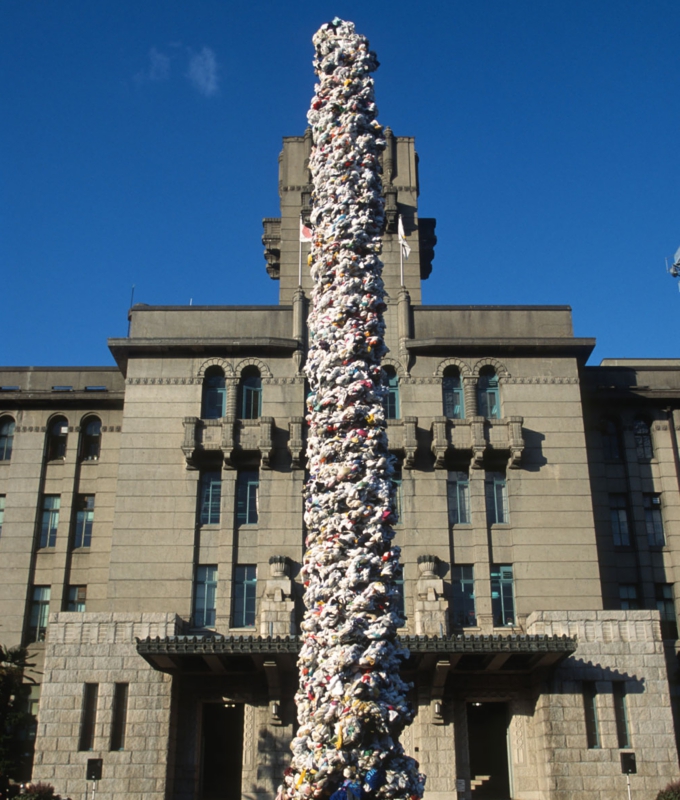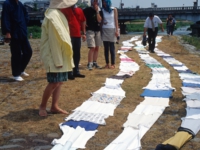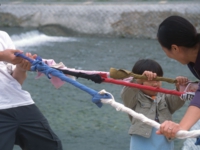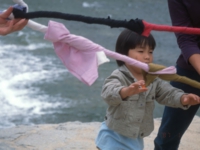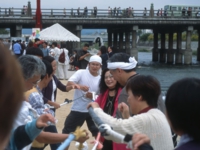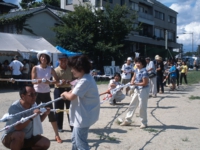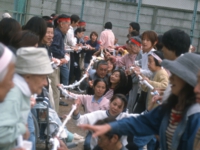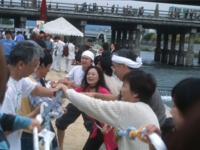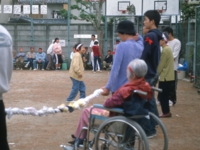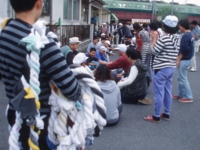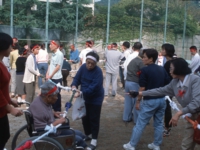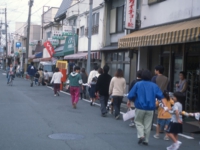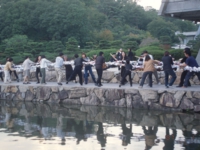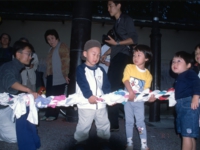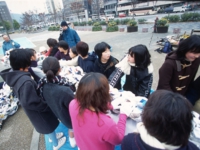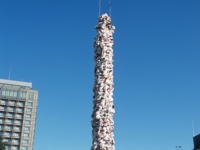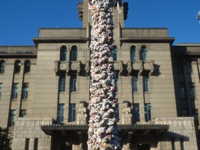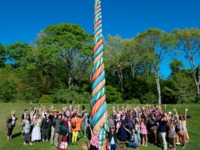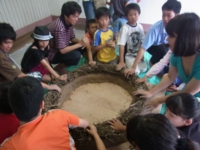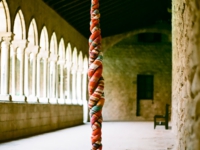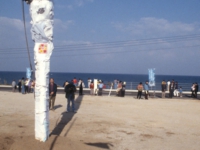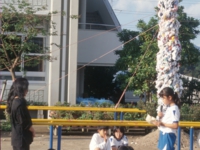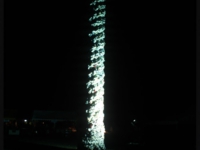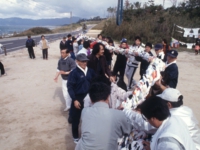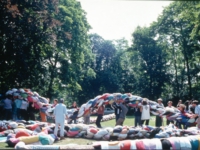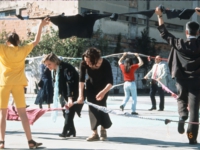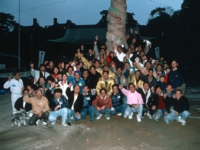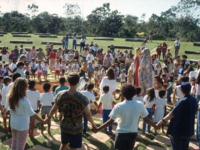「NAWA LINK」 in Kyoto
NAWA-VITAL LINK 2000, KYOTO, JAPAN
2000.7-12
NAWA-VITAL LINK 2000, KYOTO, JAPAN
The project Nawa Vital Link 2000 Kyoto brought together 10,000 people to collaboratively produce a Nawa column (11m x 1,2m diameter) called "The 21st Century-The New Earth Axis". The Nawa column was made with 10,000 worn T-shirts inscribed with individual messages for the 21st Century. The Nawa column was erected in Kyoto City Hall Plaza. Using only sunlight and a magnifying glass, fire was created and used to ignite a ritual burning of the entire column. "Because Kyoto has the most traditional culture and is the most conservative city in Japan, I wanted to create a new stream of fresh air through this project to revitalize Kyoto." Mariyo Yagi was able to collaborate with the Kyoto Fire Brigade, who gave a special exception to allow the burning ritual, and became a part of the performance as they stood by in their red fire trucks spraying a mist of water while the fire ritual was performed.
From July, 2000 to December NAWA LINK
WORK
2000
12000 citizen participation collaboration art
Yagi began to recognize
the coiled form in many facets of life, from the
weave of a simple sweater to the molecular
structure of DNA. Rope also gave her a metaphor
for human society — weak strands bound together
in a unit that is stronger than its parts. written by John Christakos
Since the Rio Earth Summit, I have sought to develop a more formal moral and philosophical theory of life emerging out of this artistic practice. I term this theory, “Nawalogy.” (In 1998, this theoretical work led to my receiving a Doctor of Humanities Honoris Cause from Anaheim University.) Through artistic and ritual events of what I term “Social Art,” I have created installation works and permanent monuments known as “Nawa Vital Link Projects,” artistic collaborations that actively unite people and communities in the spirit of peace. These projects establish intimate person-to-person links on a monumental scale; people’s worn and inscribed T-shirts are gathered together to create a monumental rope, a gigantic “nawa” column that symbolically bind together a great range of persons, from children to the elderly, transcending all boundaries and differences in background. This work has contributed to the revitalization of labor unions and communities, awakening relations between nature and people, between cultures and people, and between individuals, helping to nurture social harmony in our common struggle for world peace.
We should always consider our choices for better future.
We should not forget our roots in this modern simple society. Sometimes convenience kills originality. We forgot that us, human also is made of organic fiber. Human is also a part of the nature, a part of Cosmos and link to all living things and nature toward cosmos. I seek in my work to help foster these renewed connections in cities around the world, to help us re-discover the organic processes that bind us all to the Earth.
To make a rope, there are always at least two opposing things. One strand is weak, but when two or more strands are interwoven, it becomes strong. The same is true in society. Only one person cannot make a society. As Nawa is made of many different materials--a variety of grasses, some weaker, some different colors-- societies, too, are made of people from different backgrounds, different customs; and in the intertwining, each contributes to the greater strength of the whole. During the twisting process, the strength of the twining must be the same or the nawa will not be smooth. It requires the same power of each twist.
I have made a number of sculptures of enormously thick nawa rope, or “Nawa Vital Link” projects. They are artistic collaborations that actively unite people and communities, and help to integrate our diverse human capacities. These gigantic nawa columns we create symbolically bind together a great range of people, from children to the elderly, transcending all boundaries and differences in background. Each person has a responsibility for a part of the nawa . One rope can weigh up to two tons and it requires everyone's concentration to make it stand. After it is standing, everyone feels a sense of completion and has a greater confidence about themselves and others.
It is hard, heavy work, so we chant na wa, to create a rhythm, which is fundamental to the process.
In ancient Japanese, na means you and wa means I. So nawa is oneness with variety and diversity. It is a bonding of spirit between man and nature, and between people and people. It is collaborative community art. I want people to not just view my art, but be active participants in its making. Both the creation process and the process following the completion of the work, where the usage of the space is further developed, is part of the entire artistic activity. I am concerned with re-infusing the human spirit into everyday experiences of lived public space.
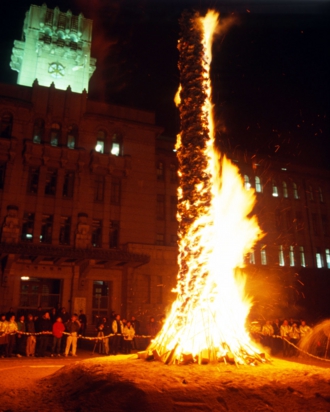
I erect the tower of the 11m in height 1 or 2m in diameter rope with approximately 10,000 pieces of old clothes T-shirts in the open space in front of Kyoto-Government building on completion December 25 and fire it by art ceremony.
I had I became a practice chairperson, and it be to a vice chairman to Shinsho Kajita of the Temple of Honenin in order to form an executive committee on performing 2000 rope by vital link Kyoto. When the Kajita chief priest wanted to submit the enthusiasm of the person from Kyoto to rope by vital link project in the future of Kyoto, it was carried out with enthusiasm. For a half year. I called for the participation of people while giving a lecture in the various places in Kyoto and continued performing making a rope at the point where a nursery school, a kindergarten, an elementary school, a junior high school, a university, a local meeting, a mental hospital, a work place, the place of the festival, an event meeting place, a park, every people gathered. I erected the tower of the rope after many processes from the rope-enclosed riding ground to a large rope in six months. After having passed through much difficulty visiting places to build the tower of the rope, finally I got the permission of installing it in the open space in front of Kyoto Government building. This project began including a government office from a preliminary stage by getting over unsociable regionality, conservative regionality, every divided social obstacle.
References, 2000 rope by Vital link Kyoto booklets
